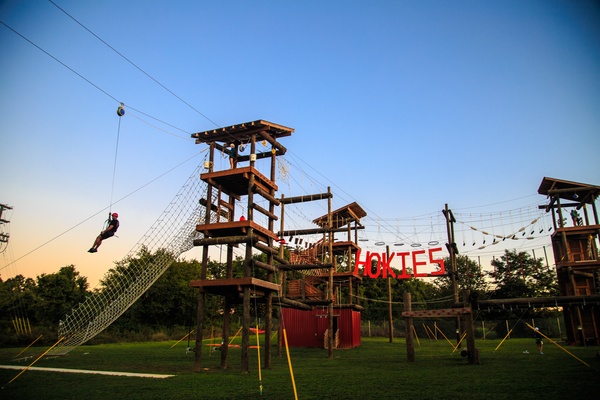


Designing and building an Aerial Adventure Park is an exciting venture, offering unforgettable outdoor experiences for visitors while providing a potentially lucrative business opportunity for owners. However, one of the first questions we get is, “How much will it cost?” The answer isn’t straightforward, as the cost of an Aerial Adventure Park designed and built by Challenge Design Innovations can range anywhere from $195,000 to over $1,000,000. This wide range reflects the many variables and complexities that go into the design and construction process.
In this post, we’ll take a closer look at the factors that influence the cost of creating an Aerial Adventure Park, giving you a better understanding of where your investment will go and how you can plan your project effectively.
The first consideration when pricing an adventure park is the size and scale of the project. A smaller 4 pole course with fewer elements will naturally cost less than a large-scale commercial park with numerous elements, large towers, and perhaps several zip line or other exit elements. Some key scope-related questions that affect costs include:
Larger parks require more materials, more time, and more labor, which directly increases the project cost. Designers and builders like CDI will work closely with you to determine the appropriate scale for your budget and goals.
The physical site where the course will be built can play a big role in determining overall costs. Considerations include:
A detailed site assessment is often one of the first steps in the design process, allowing the team to anticipate potential challenges and costs to better plan the budget.
The materials used to build your park are a significant cost driver. High-quality, durable materials are essential for ensuring safety, longevity, and compliance with industry standards. Some factors influencing material costs include:
Additionally, labor costs associated with construction can vary depending on the complexity of the design and the number of skilled workers required. Cutting corners on materials means increased maintenance costs and potential safety issues down the road.
Building an Aerial Adventure Park isn’t as simple as putting up poles, platforms, and zip lines. You’ll need to navigate a variety of permits, inspections, and regulatory requirements to ensure your park is safe and legally compliant.
The costs associated with these processes can vary significantly depending on your location and the complexity of the project.
Every Aerial Adventure Park is unique, and the level of customization you desire will directly impact the cost. CDI specializes in designing parks that are tailored to your vision, but added complexity will require more time and resources. Factors that influence design costs include:
The most successful parks balance distinctive design with practical budget considerations.
Safety isn't where you want to economize and investing in reliable safety systems is a critical part of the budget. There are several options to choose from, and each has a different cost implication:
Your safety system choice affects not just construction costs but your long-term operational model.
When budgeting, it’s also essential to think beyond construction and consider the costs of operating and maintaining the park. Some of these costs include:
A well-designed park will minimize long-term maintenance costs, but it’s important to plan for these expenses upfront.
Finally, the overall cost of your park will depend on your specific business goals. Are you looking to create a small private use course at a summer camp or school, or are you envisioning a large-scale destination that will attract people from across the region? Your target audience, desired revenue, and estimated ROI will all influence your budget decisions.
The cost of designing and building an Aerial Adventure Park is driven by a lot of factors, from the site conditions to the safety systems you choose. While the price range of $195,000 to $1,000,000 may seem very broad, working with an experienced builder like CDI can help every dollar you invest going towards creating a high-quality and engaging course that meets your vision and business/use goals.
It’s essential to start with a clear understanding of your goals, budget, and site conditions. CDI will work closely with you to navigate these complexities and deliver a course that exceeds your expectations.
Ready to get started? Contact CDI today for a consultation and let’s bring your adventure park dreams to life! https://challengedesign.com/
Share on Twitter Share on Facebook